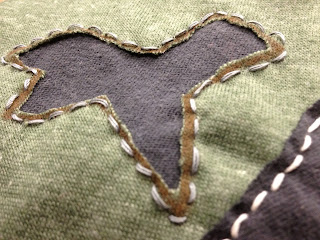 |
| My back stitched reverse applique |
In class we focused on a few different couture techniques that are used in slow fashion. The first, embroidery, is used frequently by Alabama Chanin. It involves hand stitching designs and fabric appliques to the clothing. The look that is achieved by hand stitching cannot be duplicated on a machine. Hand stitching gives the garment a natural, non-symmetrical feeling that looks less industrial and programmed. In class we experimented with a few different kinds of simple stitches (running stitch, and back stitch), and practiced appliques and reverse appliques.
 |
| My attempt at needle felting |
 |
| My 2 types of origami fabric pleats |
Finally we tried our hand at origami pleating. This is like regular origami except on fabric. By using origami pleating, you can create really interesting shapes and patterns that have depth and structure. We did two types in class. The first was a to create a three dimensional square by folding and twisting the fabric in a specific way, like normal origami. The second way we achieved the origami look was by using a pattern to sew anchor points to shapes on a piece of fabric. We then tightened the anchor points to create a 3D bulged in the fabric, and flattened them out to their original shapes. It sounds weird, but it was actually pretty easy. Once you iron these fabric shapes down, the turn into really beautiful architectural creations.
Our final project for the class will be to combine all of the different sustainable fashion components together for a total sustainable look. I plan to incorporate some embroidery and origami pleating into my garments to acknowledge slow fashion.
The popularity of Etsy.com, a shop where you can search for exclusively handmade items, is proof that the public is interested in handmade goods. Sew Little Fabric
ReplyDelete